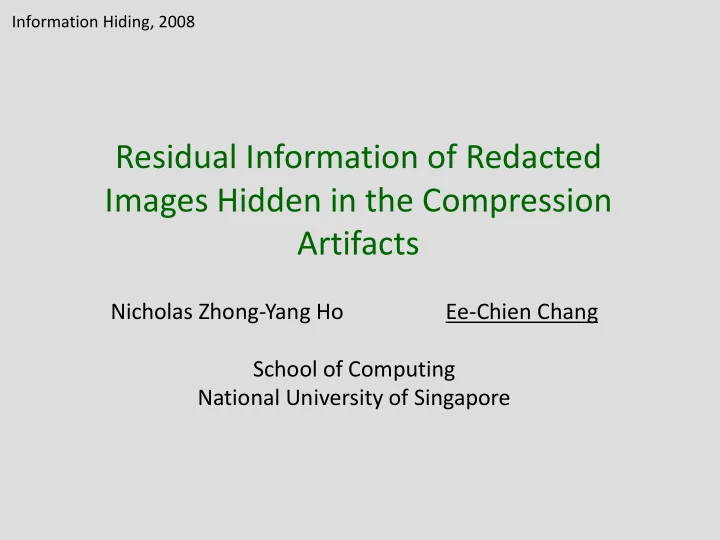

Information Hiding, 2008 Residual Information of Redacted Images Hidden in the Compression Artifacts Nicholas Zhong-Yang Ho Ee-Chien Chang School of Computing National University of Singapore
Background • Many images needed to be redacted before they are released to the public. examples from WWW
examples from WWW
Type of redaction studied in this talk. constructed example
Type of redaction studied in this talk. constructed example Pixels in the sensitive region are replaced by black/white pixels
Goal: How effective is digital redaction? • Under certain conditions, we still can extract information from the surrounding pixels.
Main Observation • Images are lossily-compressed or processed before redaction. Information in the sensitive region may has spread to the non-sensitive region before redaction. Hence, replacement of pixels values in the sensitive region does not completely purge the sensitive information.
Compression Artifacts JPEG image
Compression artifacts JPEG image Image enhanced to illustrated the artifacts
Other types of redaction • Physical redaction overwritten with marker. cover with tape while scanning. cutting out the region. • Redaction of non-pixel representation. redaction of pdf file. • Information derived from content. for e.g. length of words covered.
• We are concern with digital redaction. • Derive information from image processing artifacts.
I. Formulation: Redaction • A redacted image has been compressed at least twice. compression compression parameters parameters δ 1 δ 2 I 2 I 0 I 3 I 1 comp redact comp replacing redacted raw the pixels image image by a mask. From I 3 , actual δ 2 can be obtained, and an est stimate of δ 1 also can be obtained
Formulation: adversary’s goal • Given a redacted image I, where region containing a secret is removed. An adversary has two templates T 0 , T 1 derived from two possible values of the secret 0,1. The adversary wants to guess which template is the original. If the chance of correct guess is 0.5 + ε , then ε is the advantage of the adversary. • If adversary achieve non-zero advantage, the redacted image must has leaked some information of the secret.
Redacted image I 3 Templates T 0 T 1
II. Method 1: Estimate the Raw • Suppose a good estimate, R, of the raw image in the non- sensitive region is available, then candidates of the whole raw image can be constructed. • Simulate the redaction process and compare the outcomes. δ 1 δ 2 ~ 0 I 3 R Å T 0 I 2 comp redact I 1 comp δ 1 δ 2 ~ 1 I 3 I 2 R Å T 1 comp redact comp I 1 Compare distant of the actual redacted image ~ 0 ~ 1 I 3 with and respectively I 3 I 3
• Suitable for JPEG. • Difficult to apply to Wavelet-based compression schemes.
Method 2: Quantization error • Ignore effect of the 2 nd compression (treat it as noise). • Has an estimate of the raw image in the sensitive region (the 2 templates). • Simulate the first compression to get an estimate of the compressed sensitive region. • Obtain an estimate of I 1 . (the compressed original) • I 1 should follow the statistics of images compressed with δ 1 (quantization error). δ 1 δ 2 I 2 I 0 I 3 I 1 comp redact comp
III. Noise and parameters Estimation of the 1 st compression • δ 1 : parameter. • T 0 , T 1 : Estimation of raw image in the sensitive region (templates) • R: Estimation of the raw image in non- sensitive region • Size of redacted region. • Compression schemes and rates.
IV. Experiments • Two compression schemes: JPEG: Quantization matrix Wavelet-based compression: CDF 9/11wavelet, and uniform quantization.
Data sets • Random Images. • 2 images: Document + Photo. 1034x1494 pixels Nokia 6125 mobile phone 640x480 redacted region “normal” 70x28 compression quality template derive from photo captured by digital cameras.
Effect of redacted region + noise on templates Random images, JPEG, method 2, δ 1 =50, δ 2 = 95.
The1 st and 2 nd compression Random images, method 2, JPEG, δ 1 = 50
Effect on estimation of δ 1 Random images, method 2, JPEG, δ 1 = 40, δ 2 = 90
Effect on size of redacted region Random images, method 2, Wavelet, δ 1 = 50
Comparison of method 1 and 2 Random images, JPEG, δ 2 = 95, 3 col’s redacted
Document image, method 2, JPEG, δ 1 = 50
Document image, method 2, Wavelet, δ 2 = 1/100
Photo images(method 2) Quantization Quantization Error Error Random 123.0 Random 104.9 10-335 92.6 10-335 69.1 10-339 92.2 10-339 67.1 08-331 95.0 08-331 71.7 11-335 96.9 11-335 72.8 11-339 97.3 11-339 73.7 actual:10-339 actual:10-335
Other details • Translation and Geometric distortion. • Many DCT blocks.
Conclusion • When 2 nd compression is of higher rate, adversary’s success rate is high. • Fortunately, typical images in public domain use lower rate for 2 nd compression. (image scanned in high quality, redacted image stored in lower quality for fast downloading). • Nevertheless, mobile phone camera is gaining popularity and images compressed in lower quality. Declassification of document images may not take the downloading speed as a consideration. • Such subtle attack must still be taken into consideration when redacting sensitive images. • Other similar attacks? A more accurate model and effective method.
Recommend
More recommend